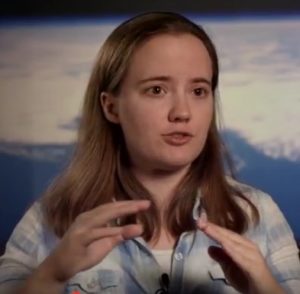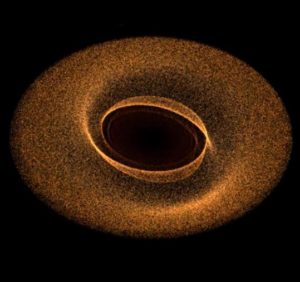 In this video, a new NASA supercomputer simulation depicts the planet and debris disk around the nearby star Beta Pictoris reveals that the planet’s motion drives spiral waves throughout the disk, a phenomenon that greatly increases collisions among the orbiting debris. Patterns in the collisions and the resulting dust appear to account for many observed features that previous research has been unable to fully explain.
In this video, a new NASA supercomputer simulation depicts the planet and debris disk around the nearby star Beta Pictoris reveals that the planet’s motion drives spiral waves throughout the disk, a phenomenon that greatly increases collisions among the orbiting debris. Patterns in the collisions and the resulting dust appear to account for many observed features that previous research has been unable to fully explain.
“Astronomers Erika Nesvold (UMBC) and Marc Kuchner (NASA Goddard) essentially created a virtual Beta Pictoris in the computer and watched it evolve over millions of years. It is the first full 3-D model of a debris disk where scientists can watch the development of asymmetric features formed by planets, like warps and eccentric rings, and also track collisions among the particles at the same time.”
Keeping tabs on thousands of fragmenting particles over millions of years is a computationally difficult task. Existing models either weren’t stable over a sufficiently long time or contained approximations that could mask some of the structure Nesvold and Kuchner were looking for.
Working with Margaret Pan and Hanno Rein, both now at the University of Toronto, they developed a method where each particle in the simulation represents a cluster of bodies with a range of sizes and similar motions. By tracking how these “superparticles” interact, they could see how collisions among trillions of fragments produce dust and, combined with other forces in the disk, shape it into the kinds of patterns seen by telescopes. The technique, called the Superparticle-Method Algorithm for Collisions in Kuiper belts (SMACK), also greatly reduces the time required to run such a complex computation.
 Using the 3.94 Petaflop Discover supercomputer operated by the NASA Center for Climate Simulation at Goddard, the SMACK-driven Beta Pictoris model ran for 11 days and tracked the evolution of 100,000 superparticles over the lifetime of the disk.
Using the 3.94 Petaflop Discover supercomputer operated by the NASA Center for Climate Simulation at Goddard, the SMACK-driven Beta Pictoris model ran for 11 days and tracked the evolution of 100,000 superparticles over the lifetime of the disk.
Read the Full Story




